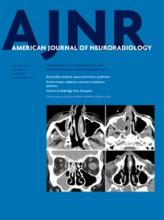Research ArticleAdult Brain
Open Access
Evaluating CT Perfusion Deficits in Global Cerebral Edema after Aneurysmal Subarachnoid Hemorrhage
H. Baradaran, V. Fodera, D. Mir, K. Kesavobhotla, J. Ivanidze, U. Ozbek, A. Gupta, J. Claassen and P.C. Sanelli
American Journal of Neuroradiology August 2015, 36 (8) 1431-1435; DOI: https://doi.org/10.3174/ajnr.A4328
H. Baradaran
aFrom the Departments of Radiology (H.B., V.F., D.M., K.K., J.I., A.G.)
V. Fodera
aFrom the Departments of Radiology (H.B., V.F., D.M., K.K., J.I., A.G.)
D. Mir
aFrom the Departments of Radiology (H.B., V.F., D.M., K.K., J.I., A.G.)
K. Kesavobhotla
aFrom the Departments of Radiology (H.B., V.F., D.M., K.K., J.I., A.G.)
J. Ivanidze
aFrom the Departments of Radiology (H.B., V.F., D.M., K.K., J.I., A.G.)
U. Ozbek
bPublic Health (U.O.), NewYork-Presbyterian Hospital, Weill Cornell Medical College, New York, New York
A. Gupta
aFrom the Departments of Radiology (H.B., V.F., D.M., K.K., J.I., A.G.)
J. Claassen
cDepartment of Neurology (J.C.), NewYork-Presbyterian Hospital, Columbia University Medical Center, New York, New York
P.C. Sanelli
dDepartment of Radiology (P.C.S.), North-Shore–Long Island Jewish Health System, Great Neck, New York.

References
- 1.↵
- Hop JW,
- Rinkel GJ,
- Algra A, et al
- 2.↵
- Ingall T,
- Asplund K,
- Mähönen M, et al
- 3.↵
- 4.↵
- Feigin VL,
- Lawes CM,
- Bennett DA, et al
- 5.↵
- Molyneux AJ,
- Kerr RSC,
- Birks J, et al
- 6.↵
- Springer MV,
- Schmidt JM,
- Wartenberg KE, et al
- 7.↵
- Roos YB,
- Dijkgraaf MG,
- Albrecht KW, et al
- 8.↵
- 9.↵
- 10.↵
- Claassen J,
- Carhuapoma JR,
- Kreiter KT, et al
- 11.↵
- Kreiter KT,
- Copeland D,
- Bernardini GL, et al
- 12.↵
- 13.↵
- Mocco J,
- Prickett CS,
- Komotar RJ, et al
- 14.↵
- Zetterling M,
- Hallberg L,
- Hillered L, et al
- 15.↵
- Helbok R,
- Ko SB,
- Schmidt JM, et al
- 16.↵
- Grote E,
- Hassler W
- 17.↵
- Wintermark M,
- Maeder P,
- Thiran JP, et al
- 18.↵
- Sanelli PC,
- Lev MH,
- Eastwood JD, et al
- 19.↵
- Wintermark M,
- Lau BC,
- Chien J, et al
- 20.↵
- Shin BJ,
- Anumula N,
- Hurtado-Rúa S, et al
- 21.↵
- 22.↵
- Murphy BD,
- Fox AJ,
- Lee DH, et al
- 23.↵
- van Asch CJ,
- van der Schaaf IC,
- Rinkel GJ
- 24.↵
- Aralasmak A,
- Akyuz M,
- Ozkaynak C, et al
- 25.↵
- Weidauer S,
- Lanfermann H,
- Raabe A, et al
- 26.↵
- Vergouwen MD,
- Vermeulen M,
- Coert BA, et al
- 27.↵
- Kassell NF,
- Torner JC,
- Haley EC, et al
In this issue
American Journal of Neuroradiology
Vol. 36, Issue 8
1 Aug 2015
Advertisement
H. Baradaran, V. Fodera, D. Mir, K. Kesavobhotla, J. Ivanidze, U. Ozbek, A. Gupta, J. Claassen, P.C. Sanelli
Evaluating CT Perfusion Deficits in Global Cerebral Edema after Aneurysmal Subarachnoid Hemorrhage
American Journal of Neuroradiology Aug 2015, 36 (8) 1431-1435; DOI: 10.3174/ajnr.A4328
0 Responses
Jump to section
Related Articles
Cited By...
This article has not yet been cited by articles in journals that are participating in Crossref Cited-by Linking.
More in this TOC Section
Similar Articles
Advertisement











